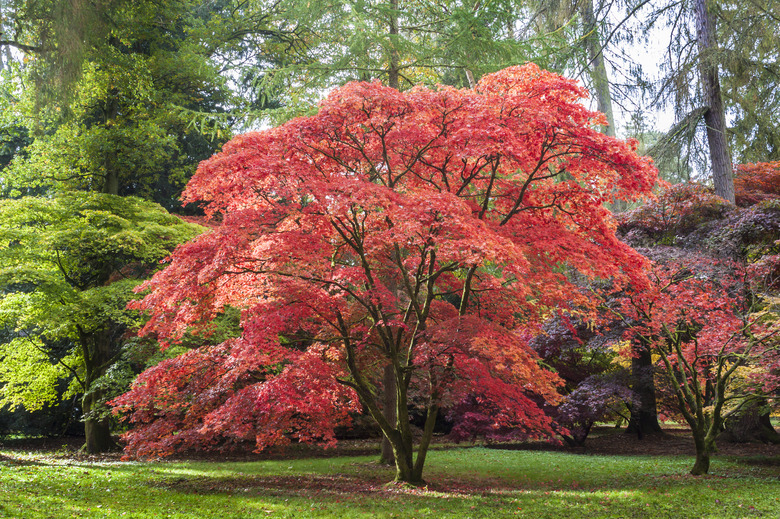How Does A Japanese Maple Tree Carry Out Photosynthesis?
In a maple tree with purple leaves, like a Japanese maple (Acer palmatum), how does photosynthesis happen? Native to Asia and hardy in United States Department of Agriculture zones 5b to 8a, Japanese maple leaves are red or reddish-purple instead of the green you see in most plant leaves.
In a maple tree with purple or reddish leaves like this, pigments called anthocyanins are coloring the leaves, which obscures the green color of the photosynthetic pigment called chlorophyll. A Japanese maple tree leaf may be a different color from the leaf of a sugar maple, but it is still absorbing light from the sun to make its own food through photosynthesis.
Japanese Maple Colors
Japanese Maple Colors
The color of Japanese maple leaves varies through the growing season, with shades including green, red, orange, purple and pink. Determined by the amount and type of anthocyanins present, the color of the leaves is different for each variety, or cultivar.
Japanese maple trees are deciduous, which means that they lose their leaves in the winter. Some leaves may appear green or yellowish in the spring, turn red in the summer and then mature to a coppery tone before falling off in the autumn.
Regardless of the color or season, when leaves are on a Japanese maple, they are helping to make food for the tree through photosynthesis. All leaves contain a variety of plant pigments, including those that appear green. Leaves that look red or purple contain the chlorophyll needed for photosynthesis, but they have a high concentration of anthocyanins too. This same concept helps explain how leaves change colors in the fall.
Pigments in Leaves
Pigments in Leaves
Chlorophyll, the green pigment that is dominant in most plant tissues, is necessary for photosynthesis. Found in the chloroplasts of plant cells, chlorophyll absorbs light in the red part of the wavelength spectrum. The reason that chlorophyll looks green is that it reflects the wavelengths of light in the green part of the spectrum.
Plants use the light energy absorbed by chlorophyll to carry out photosynthesis, which is the process of converting carbon dioxide and water into food to fuel plant cells. Leaves are the primary sunlight-absorbing structures of plants, so this is why many leaves appear green.
There are several other pigments present in plants, including anthocyanins, which give the leaves of Japanese maples their different colors. Because anthocyanins absorb light in the green part of the spectrum and reflect red wavelengths, they appear red, orange or purple.
Anthocyanins have many functions in plant tissues, such as protecting leaves from too much sunlight by acting as a "sunscreen" or shield. Other purposes of anthocyanins include attracting pollinators to flowers or deterring plant-eating animals from leaves.
Color Change in Fall
Color Change in Fall
The color changes you see in the leaves of deciduous trees in the fall helps explain a maple tree with dark purple leaves. Knowing that tree leaves contain a variety of pigments, it makes sense that as the leaves slowly die in the autumn, they also stop photosynthesizing. Because they don't need chlorophyll for photosynthesis, the green pigment degrades in the sunlight over the course of a few weeks in the autumn.
As the chlorophyll is broken down, the color of other pigments, like anthocyanins, comes through. In an area like the northeastern United States, this can make for a brilliant display of changing colors in the late fall. Of course, evergreen trees continue to photosynthesize all year, so they do not lose their needle-like leaves in the fall, remaining green because they still need chlorophyll to collect energy from the sun in the winter.
References
- North Carolina State Extension: Acer Palmatum
- University of California, Santa Barbara: Leaves of Plants Like Cabbage Are Purple in Color, Then How Are They Able to Carry out Photosynthesis?
- University of California, Santa Barbara: Do Plants With Non Green Leaves Have Chlorophyll and Photosynthesis?
- Universities Space Research Association: Why Are Some Leaves Not Green?
- Smithsonian: Autumn Splendor: Why Do Leaves Change Color in the Fall?
Cite This Article
MLA
Sloane, Christina. "How Does A Japanese Maple Tree Carry Out Photosynthesis?" sciencing.com, https://www.sciencing.com/how-does-a-japanese-maple-tree-carry-out-photosynthesis-13428784/. 30 September 2021.
APA
Sloane, Christina. (2021, September 30). How Does A Japanese Maple Tree Carry Out Photosynthesis?. sciencing.com. Retrieved from https://www.sciencing.com/how-does-a-japanese-maple-tree-carry-out-photosynthesis-13428784/
Chicago
Sloane, Christina. How Does A Japanese Maple Tree Carry Out Photosynthesis? last modified March 24, 2022. https://www.sciencing.com/how-does-a-japanese-maple-tree-carry-out-photosynthesis-13428784/
